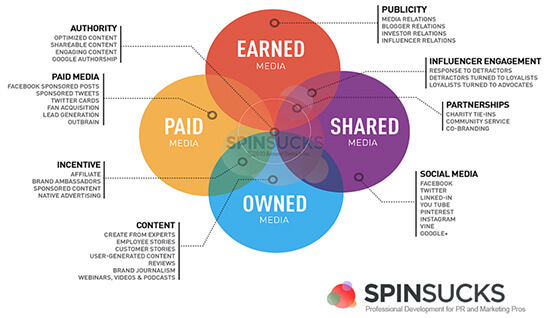
Heard of paid, earned, shared and owned media? How do these different online and media channels influence your content marketing strategy?
In this article, you will learn about the differences between paid, earned, shared and owned media, and how you can optimize them for your content marketing efforts.
Before we dive into each of these digital media types, it is useful to look at how they can all come together.
Here, I would like to refer to the PESO model—Paid, Earned, Shared, and Owned media—that is specially developed by Gini Dietrich from Spin Sucks. You can take a look at how it is broken down into four overlapping circles as shown in this infographic.

Courtesy of Spin Sucks
In thinking about the different types of media channels and platforms, it is useful to consider the following questions:
- Do these media channels help you to hit your content marketing goals?
- Are they reaching the right audiences at the right places in the right frame of mind?
- How do they drive traffic and influence behaviours through your content marketing funnel?
- When should you use paid, earned, shared and owned media in your content marketing calendar?
- What are the best strategies you can employ for paid, earned, shared and owned media?
Let us look at each of these in more detail.
#1 Investing in Paid Media
While most people regard any form of advertising as Paid Media, I’ll prefer to use the term paid media to mean amplifying or boosting your content efforts through paid channels.
In this case, it could refer to any of the following:
- Social Media Sponsored Posts: All the major social networks offer advertising options—Facebook; LinkedIn; Twitter; Instagram; Pinterest; and YouTube.
- Native Advertising: These are ads that don’t look like ads—they usually take the form of advertorials or sponsored articles on media channels. You can read more about native ads here.
- Paid Influencers: For the more prominent A-list influencers or celebrity influencers, you’ll normally have to fork out some dough to get them to post on their blog, Instagram accounts or YouTube channels for you.
- Display Ads or Search Ads: Beyond the above, you may also consider Pay Per Click (PPC) advertising channels like Google’s Search Ads or Display Ads. These can be targeted based on regions, interests, demographics, and channels, depending on the characteristics of your target audiences.
When you consider spending money in any paid media tactics, it is useful to consider the following principles:
- How do paid media channels augment your current owned and earned media?
- How do you calculate the ROI of content marketing advertising? Here’s one way to do so.
- Paid media channels are normally used to scale up your organic content marketing efforts. Hence, they should be used only after you’ve laid the foundations for your owned, earned and shared media channels.
#2 Cultivating Earned Media
What does Earned Media mean? Here’s a definition you can use:
Earned media is the publicity mileage that you can generate through pitching and promotional efforts that does not involve paying for media. This can be media articles, news reports, radio news reports, blog articles, social media posts, and other forms of coverage by third parties on traditional or social media platforms.
When it comes to Earned Media, the two key strategies which you need to employ are public relations and influencer engagement.
Digital Public Relations
In the online world, PR is similar in some respects to offline PR yet different. While digital public relations also involves cultivating relationships with journalists, editors and reporters, the role also covers pitching of guest articles for blogs and websites, as well as reciprocal PR arrangements with other online channels.
(Learn more about digital PR in my recent article here.)
Influencer Engagement
Also known as Influencer Marketing, engaging with bloggers, Instagrammers, YouTubers, and other social media influencers is both an art and a science.
Depending on the nature of your industry and its competitiveness, working with influencers can help you to extend your reach way beyond your traditional markets.
Here’s a simple six-step process you can use to hire influencers for your content marketing efforts:
- Use an influencer platform or social media group to find the right influencers
- Check for the right content fit with your brand
- Check that the influencer belongs to the right niche, and has the relevant domain expertise
- Check that the influencer’s followers and fans are right for your brand
- Look at the influencer’s previous sponsored posts and critically evaluate them
- Establish if the influencer’s brand fits your own brand
#3 Generating Shared Media
Next, we turn our attention to Shared Media, which is simply a fancy way to describe social media channels.
Examples of shared media would be social networks like Facebook, Twitter, Instagram, YouTube, LinkedIn, Pinterest, WhatsApp, WeChat, Line, Telegram… The list goes on and on…
What’s more important than identifying the different social media platforms, however, is understanding how you can tap on them to get the word out.
Here, I’d like to propose two key strategies.
Deploy Viral Marketing Tactics
In the social media world, triggering virality has become a popular sport among digital marketers. While there are various ways and means to do so, here are two of my favourites:
- Newsjacking: Creating a piece of content that rides on a trending topic that is fresh off the news
- STEPPS: Deploying techniques such as social currency, triggers, high arousal emotions, publicly visible actions, and storytelling to encourage content sharing (more in the link here)
Build a Loyal Online Community
The other way to stimulate more social sharing online is to build and nurture a devoted community of fans and followers.
You can do this by setting up a special interest group online, be it as a Group (Facebook or LinkedIn) or a Page. Bear in mind that building an online community does take time and patience, so you need to play the long game here.
(Read more about building a tight-knitted online community here.)
#4 Building Owned Media
Finally, and perhaps most importantly, you need to consider how you can build your Owned Media platforms and channels.
So what are examples of owned media?
Owned media can be defined as the digital marketing channels that your company has complete control over. They include your company and product websites, blogs, social media pages and accounts, emails (and mailing lists), as well as offline publications.
In thinking about your owned media channels, it is important to consider the impact of the following:
- Creating content that is Search Engine Optimization (SEO) friendly
- Designing websites and landing pages that are optimized for conversion
- Positioning your company’s online channels more like media platforms and less like online brochures
As the foundational layer for your content marketing efforts, you need to also incorporate a regular schedule for producing content.

Integrating Content Marketing with PESO Media Channels
Now that you’ve learned what the paid, earned, shared and owned media channels are like, your next step is to see how you should weave these four types of media into your content marketing strategy.
Rather than do it in a haphazard fashion, consider taking these steps:
- Identify who your potential customers are, and which online channels they are likely to be active on
- Take stock of your owned media channels, and work towards optimising them for your target audiences
- Cultivate a strong relationship with your communities, and seek to generate shared media
- Assess where the gaps in your current reach are. Amplify your results through highly targeted paid media activities
- Augment your content marketing efforts with earned media campaigns working with publicists and influencer agencies
- Evaluate all your different content marketing channels—be they paid, earned, shared or owned—and determine the ROI of each activity vis-a-vis the time, money and manpower invested in them
I hope that this article has helped you to distinguish between the four types of media while providing some suggestions on how they can be optimized and managed.
In your opinion, what is the most important media channel of all and why? I’d love to read your thoughts.

Thanks for sharing such a wonderful piece of insurance.